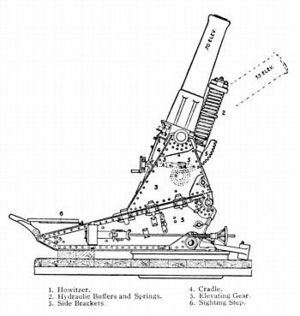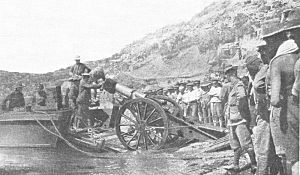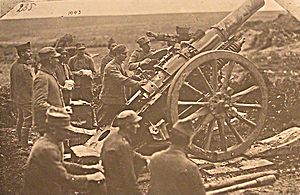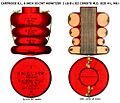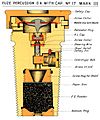BL 6-inch 30 cwt howitzer facts for kids
Quick facts for kids BL 6 inch 30 cwt Howitzer |
|
|---|---|

With breech open, circa. 1900
|
|
| Type | Medium howitzer |
| Place of origin | United Kingdom |
| Service history | |
| In service | 1896 - 1918 |
| Wars | Second Boer War World War I Greco-Turkish War (1919–1922) German invasion of Greece |
| Production history | |
| Designed | 1896 |
| No. built | 120 |
| Specifications | |
| Mass | 7733lb (3507kg) |
| Crew | 10 |
|
|
|
| Shell weight | Lyddite : 122 lb 9 oz (55.59 kg), later 100 lb (45.36 kg); Shrapnel : 100 lb (45.36 kg) |
| Calibre | 6-inch (152.4 mm) |
| Recoil | Hydro spring, 18 inch |
| Carriage | Wheeled, box trail |
| Elevation | -10° - 35° (wheeled carriage) 35° - 70° (siege mount) |
| Muzzle velocity | 777 ft/s (237 m/s) |
| Maximum firing range | 5,200 yds (122lb 9oz shell, on wheeled travelling carriage); 7,000 yds (122lb 9oz shell, on siege mounting) 7,000 yards (100 lb shell, on wheeled travelling carriage) |
The Ordnance BL 6 inch 30 cwt howitzer was a powerful British cannon. It was used in the Second Boer War and at the start of World War I. A "howitzer" is a type of artillery gun that fires shells in a high arc. This allows it to hit targets hidden behind hills or walls. The "30 cwt" part of its name tells you how much the barrel and breech (the back part of the gun where shells are loaded) weighed. It was about 3,360 pounds (1,524 kg). You can spot this howitzer by its slightly wide muzzle (the front opening) and the large springs under the barrel. These springs helped absorb the gun's kickback when it fired.
Contents
History of the Howitzer
The BL 6-inch 30 cwt howitzer was first used in 1896. Its design was based on a gun used by the Indian Army.
Originally, it fired a heavy 122-pound (55 kg) explosive shell called Lyddite. In 1901, a lighter 100-pound (45 kg) shell was introduced. This new shell could travel much farther, up to 7,000 yards (6,400 meters), when fired from its wheeled carriage. People then called these the "heavy" and "light" shells. There was also a 100-pound shrapnel shell, which exploded in the air and sent out many small metal pieces.
This howitzer was slowly replaced by a newer model, the 6 inch 26 cwt howitzer, starting in late 1915. However, in 1915, it also received some upgrades. Its barrel, breech, and recoil system were improved. It could also use new ammunition. These changes increased its maximum range to 10,400 meters (about 6.5 miles).
How it was Used in Battles
This gun was designed to be a "siege howitzer." This means it was meant for attacking strong enemy forts or cities. It fired a special heavy shell. For very accurate, long-range shots, its wheels could be removed. Then, it would be placed on a special, stable platform. When it was fired from its regular wheeled carriage, its range and accuracy were not as good. This was because it couldn't aim as high, and its recoil system was not as modern.
The Second Boer War
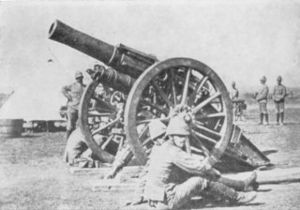
Twelve of these howitzers were sent to South Africa during the Second Boer War. They were part of the British army's "siege train," which included large guns for attacking enemy defenses. During this war, it became clear that the howitzer's range was limited. To fix this, the lighter 100-pound shell was created in 1901. This shell allowed the gun to shoot up to 7,000 yards (6,400 meters) from its wheeled carriage. The special platform for siege operations, which allowed the gun to aim very high, was not needed in South Africa. Soldiers found it was actually a hindrance.
World War I Battles
When World War I started, about 80 of these howitzers were still in use. They were the only truly heavy artillery the British army had at the time. They were used a lot in the early battles in France and Belgium. The gun was changed slightly to use a standard 100-pound shell. It served in all war zones, including the Western Front. It was replaced by a more modern 6-inch howitzer starting in late 1915. At the Battle of Gallipoli, where modern weapons were harder to get, these howitzers were still very important. They were used by British and Australian artillery units.
Serving in Greece (1917–1941)
The BL 6-inch 30 cwt howitzer joined the Greek Army in late 1917. The British Army gave 40 of these guns to Greece because Greece needed more howitzers. These guns formed a full Howitzer Regiment of 36 guns. They fought in the final parts of World War I on the Macedonian Front.
During the Greco-Turkish War (1919-1922), the Howitzer Regiment sent a squadron of these guns to Asia Minor. After February 1922, the full regiment was used there. Its nine batteries often helped strengthen other army divisions where Turkish attacks were expected.
The BL 6-inch 30 cwt howitzer stayed in the Greek Artillery for another 18 years. However, by 1932, it was considered "obsolete," meaning it was old and outdated. It also needed many repairs to work properly. Even so, at least 16 of these guns were placed along the "Metaxas Line" in late 1939. This was a line of forts along the Greek-Bulgarian border. These howitzers bravely fought against the invading German Army from April 6 to 9, 1941.
Who Used These Howitzers?
 Australia - Australia: Used 2 howitzers in the 1st Heavy Artillery Battery.
Australia - Australia: Used 2 howitzers in the 1st Heavy Artillery Battery. United Kingdom - United Kingdom: Used by the Royal Garrison Artillery.
United Kingdom - United Kingdom: Used by the Royal Garrison Artillery. Greece - Greece: Used 12 howitzers in a Howitzer Battery during World War I. Later, they used 36 howitzers in a Howitzer Regiment during the Greco-Turkish War (1919-1922).
Greece - Greece: Used 12 howitzers in a Howitzer Battery during World War I. Later, they used 36 howitzers in a Howitzer Regiment during the Greco-Turkish War (1919-1922).
See also
- 6 inch 26 cwt howitzer : The British Empire's newer howitzer that replaced this one.
- List of howitzers
Similar Howitzers from Other Countries
- 15 cm schwere Feldhaubitze M 94 : An Austro-Hungarian howitzer.
- Rimailho Model 1904TR : A French howitzer.
- 152 mm howitzer M1910 : A French/Russian howitzer.
- 15 cm sFH 02 : A German howitzer.
- 6-inch howitzer M1908 : A similar howitzer from the United States.
Where You Can See Them Today
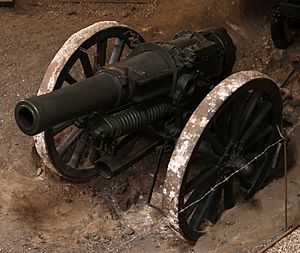
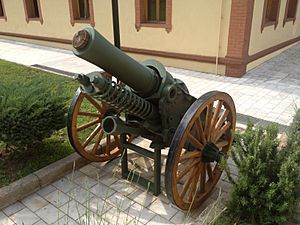
- You can find a gun at the Royal Artillery Museum in Woolwich, London.
- Another gun is at the Imperial War Museum Duxford in the UK.
- There is also a gun at the War Museum of Athens, Greece.
- You can see one at the War Museum of Thessaloniki in Salonica, Greece.
- Another "gatekeeper" gun is at the NDC-GR HQ in Salonica, Greece.
Images for kids


